One of the most common questions we get asked is how to get started with email marketing. We know everything feels overwhelming at the start — creating emails, understanding the target audience, and tracking progress.
So, we thought, why not break it all down for you—step by step? Whether you’re sending your first email or looking to sharpen your skills, this guide will help you get started quickly.
Let’s go!
What is Email Marketing?
Email marketing is a way to send information directly to your audience. You can share updates, promote products, or build relationships through your email marketing efforts.
It is one of the most profitable ways to reach out and engage your audience. In fact, you can register an ROI of up to 3600% with email marketing, better than other digital marketing channels. It works because it’s personal, direct, and easily trackable.
Sending targeted email marketing campaigns helps grow your business revenue while staying in touch with your audience where it matters most—in their inboxes.
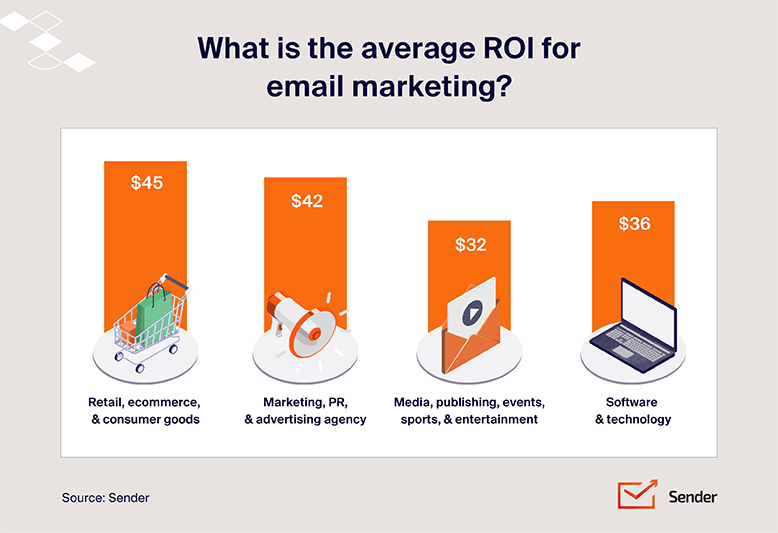
Benefits of Email Marketing
Why should email marketing be a priority in a crowded digital landscape? Especially, email marketing for small businesses? Here’s the bottom line:
- Exceptional email marketing ROI. Compared to other marketing channels, email marketing consistently delivers an impressive return on investment. 41% of marketers admit that email is their most effective marketing channel.
- Direct line to your audience. You’re speaking directly to your subscribers in their inbox, a space they check regularly and associate with personal and professional communication.
- Laser-focused targeting. Segmentation allows you to tailor your messages to specific demographics, interests, and behaviors, ensuring your message hits the mark every time;
- Conversion-driving machine. Whether it’s encouraging a sale, a sign-up, a download, or any other desired action, email marketing excels at nudging your audience towards conversion;
- Nurture lasting relationships. Regular, valuable emails help you stay top-of-mind and cultivate deeper connections with your audience, turning casual subscribers into loyal customers.
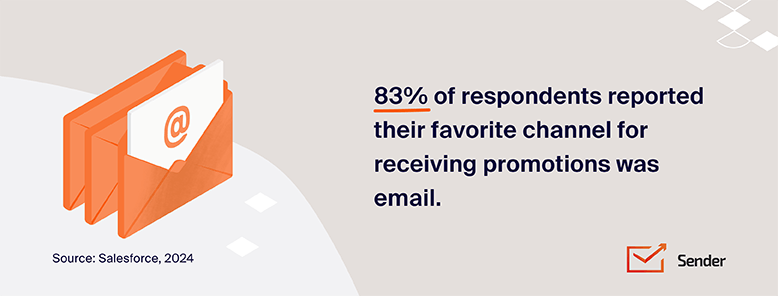
Types of Email Marketing Campaigns
Before we dive into the strategic nitty-gritty, let’s explore the diverse world of email campaigns you can use:
- Newsletters. These are your bread-and-butter emails, sent out on a regular cadence (weekly, bi-weekly, or monthly). Think of them as a way to share valuable content, company news, exclusive insights, and a behind-the-scenes peek into your brand’s world;
- Promotional emails. It’s time to shine a spotlight on your products or services! Use these emails to announce irresistible discounts, flash sales, exciting new product launches, and limited-time offers that create a sense of urgency;
- Welcome emails. These automated emails are triggered when someone joins your email list, warmly welcoming them to your community and setting the stage for a positive and engaging relationship;
- Transactional emails. These are triggered by specific actions taken by the subscriber, such as order confirmations, shipping notifications, password reset requests, or account updates;
- Re-engagement emails. Sometimes, subscribers drift away. Re-engagement emails are your chance to win them back with a compelling offer, a gentle reminder of your value, or a simple “we miss you!” message;
- Lead nurturing emails. These automated email sequences guide leads through the email marketing funnel, providing valuable information and resources to help them make informed purchasing decisions.
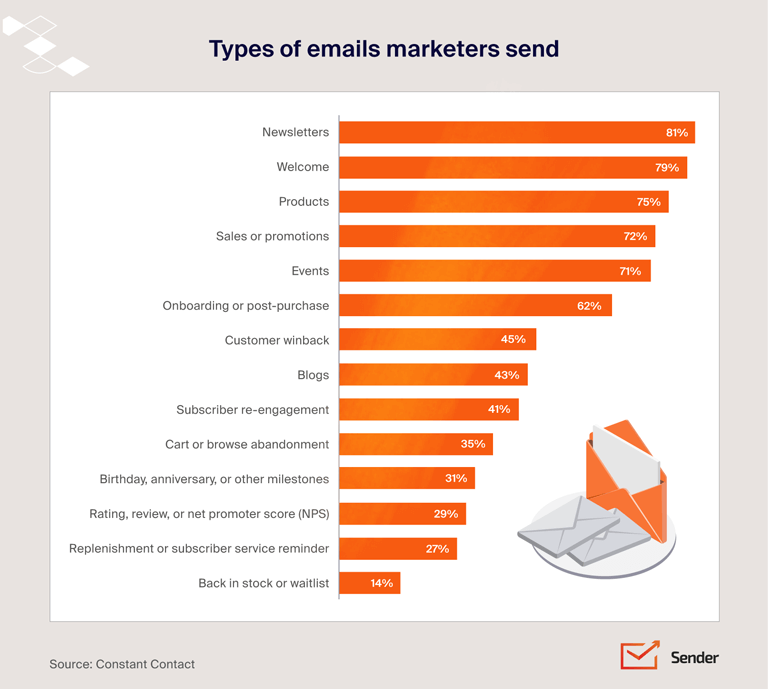
How to Do Email Marketing in 7 Simple Steps
Ready to transform your email marketing strategy? Follow these steps to craft campaigns that deliver:
- Define Your Goals
- Choose Email Marketing Platform
- Build Your Email List
- Segment Your Audience
- Craft Email Campaign
- Test and Optimize Overtime
- Automate Your Campaigns
Define Your Goals
Knowing your “why” is crucial for effective email marketing. But it’s not enough to simply say “I want more sales.” You need to dig deeper and establish SMART goals:
Specific: Clearly define what you want to achieve.
- Vague: Increase sales.
- Specific: Increase online sales of Product X by 15% in Q2.
Measurable: Ensure your goals can be tracked and quantified.
- Vague: Improve customer engagement.
- Measurable: Increase email open rates by 5% and click-through rates by 2% within the next quarter.
Attainable: Set realistic goals based on your resources and audience.
- Unrealistic: Achieve a 100% email open rate.
- Attainable: Increase email open rate to the industry average of 25%.
Relevant: Align your goals with your overall business objectives.
- Irrelevant: Grow social media following through email marketing.
- Relevant: Drive traffic from email to product pages to support sales goals.
Time-Bound: Set deadlines to create urgency and measure progress.
- Vague: Boost website traffic.
- Time-Bound: Increase website traffic from email marketing by 10% within the next three months.
And here’s how to define your email marketing goals:
1. Start with the big picture: What are your overarching business objectives? Do you want to increase revenue, launch a new product, or build brand loyalty?
2. Break it down: How can email marketing specifically contribute to these objectives?
3. Get SMART: Translate these contributions into specific, measurable, attainable, relevant, and time-bound goals.
4. Prioritize: If you have multiple goals, prioritize them based on their impact and urgency.
Choose Email Marketing Platform
Picking an email marketing software is the most important decision for the success of your campaigns.
Most email marketing services promise affordability on their marketing websites but turn costly pretty soon when you start using them. The right email marketing tool ensures you can create effective emails easily and achieve your goals.
When choosing an email marketing tool, remember the following points:
- Find one that fits your industry. Some email marketing platforms are tailored for ecommerce, others for nonprofits, or SaaS email marketing. Choose an email service provider that aligns with your needs;
- Prioritize ease of use. Look for drag-and-drop builders, ready-to-use templates, and intuitive dashboards in the email marketing tools you’re considering;
- Focus on features you’ll actually use. Check for advanced marketing tools like automation, segmentation, and analytics for creating high-performing campaigns easily;
- Check pricing plans carefully. Ensure the cost matches your business needs. Start with free or affordable plans if you’re a beginner;
- Think about the long term. Pick an email marketing service that grows with your business needs.
And here’s a rundown of some top email marketing tools:
- Sender. An excellent all-around option, especially for those just starting with email marketing. Sender boasts a user-friendly interface, a generous free plan, and a strong emphasis on email deliverability;
- Mailchimp. A household name in the email marketing world, Mailchimp offers a robust set of features, including automation, segmentation, and a drag-and-drop email builder. However, their pricing can become a consideration as your email list flourishes;
- Omnisend. Email marketing for e-commerce? Say no more. Omnisend provides powerful features like automated abandoned cart emails, personalized product recommendations, and seamless SMS marketing integration;
- Brevo. Another strong contender a smaller email marketing budget, Brevo offers a free plan with unlimited contacts and a range of features, including SMS marketing and marketing automation capabilities;
- MailerLite. Known for its intuitive interface and affordable pricing plans, MailerLite is a popular choice for small businesses, bloggers, and entrepreneurs.
Want a solution with all the premium features, human customer support, and amazing deliverability? Try Sender and enjoy sending emails at ease.
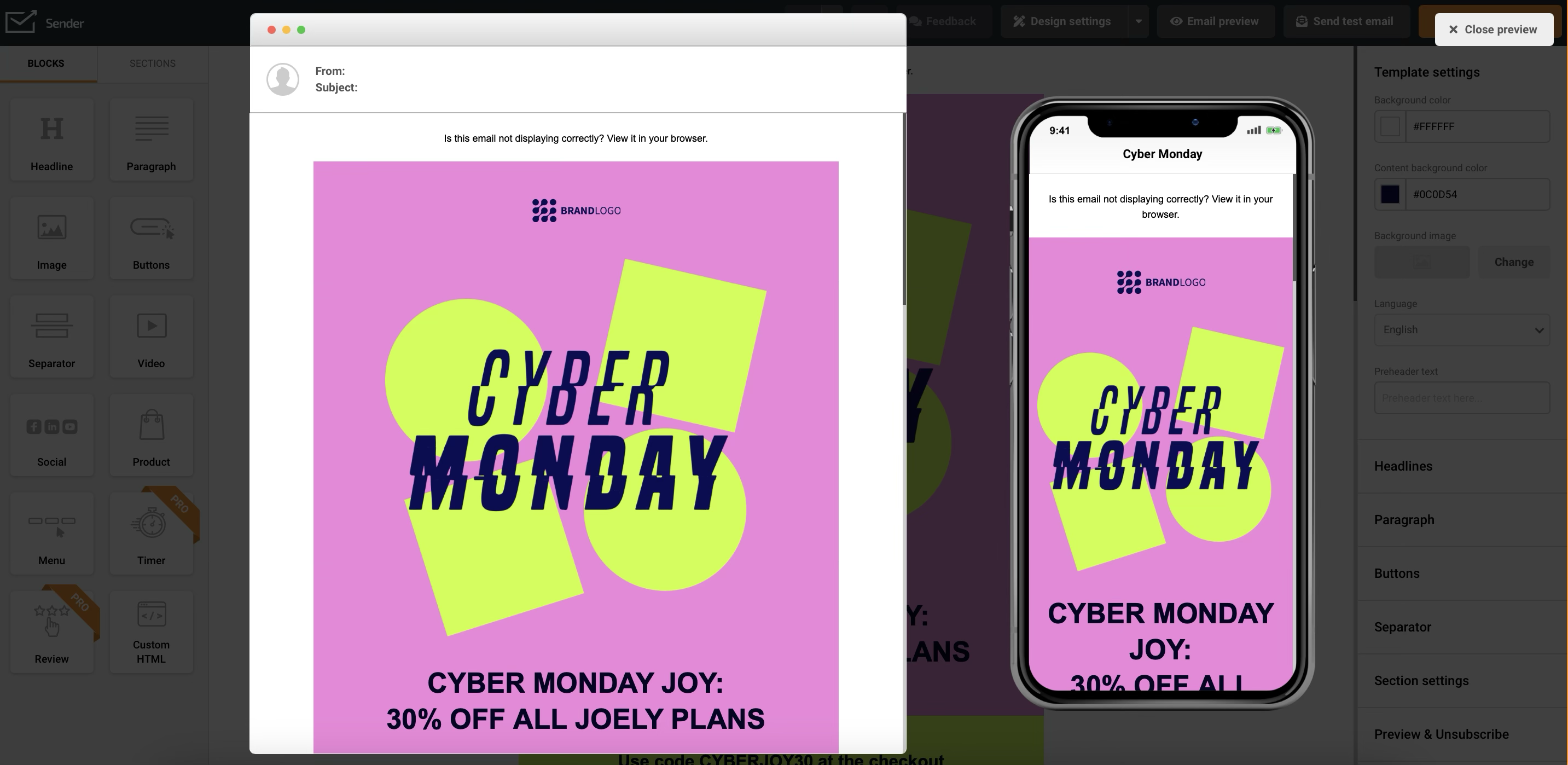
Build Your Email List
When it comes to email list building quality reigns supreme over quantity. Concentrate on attracting subscribers who are genuinely interested in your brand, your message, and what you bring to the table.
Here are some proven tactics to organically grow your email list:
- Create irresistible opt-in forms. Place visually appealing and strategically positioned opt-in forms on your website, blog, and social media profiles;
- Implement pop-up forms strategically. While sometimes perceived as intrusive, pop-up forms can be surprisingly effective when used strategically and sparingly;
- Offer valuable lead magnets. Entice potential subscribers with high-value lead magnets – think insightful ebooks, actionable checklists, time-saving templates, or exclusive discounts – in exchange for their email addresses;
- Promote your email list on social media. Spread the word! Let your social media followers know about the exclusive content, special offers, and insider perks they’ll receive by joining your email community;
- Run contests and giveaways. People love free stuff! Organize enticing contests and giveaways where email sign-ups are the entry fee.
Smart tip: Use a double opt-in. This best practice involves sending a confirmation email to new subscribers, requiring them to click a link to verify their email address. It ensures a pristine email list brimming with engaged subscribers, which works wonders for your email deliverability rates and keeps you out of the spam folder.
Segment Your Audience
Sending the same generic email blast to your entire subscriber base. Not exactly a recipe for engagement, right? That’s why you need target audience segmentation.
By dividing your subscribers into smaller, more targeted groups based on shared characteristics, you can deliver hyper-relevant messages that feel tailor-made for each individual.
Email segmentation criteria to consider:
- Demographics. Age, gender, location, language, profession;
- Interests. What are your subscribers passionate about? What products or content pique their interest?;
- Purchase history. Past purchases, purchase frequency, average order value – these are goldmines of insight into customer behavior;
- Website activity. Pages visited, products viewed, content downloaded – these digital footprints reveal valuable information about subscriber interests;
- Email engagement. Open rates, click-through rates, email frequency preferences – these metrics speak volumes about subscriber engagement levels.
Advanced tip. Take your segmentation game to the next level with behavioral email triggers. These automated emails are sent based on specific actions a subscriber takes, such as abandoning their shopping cart, browsing a particular product category, or completing a purchase. This level of personalization is incredibly powerful.
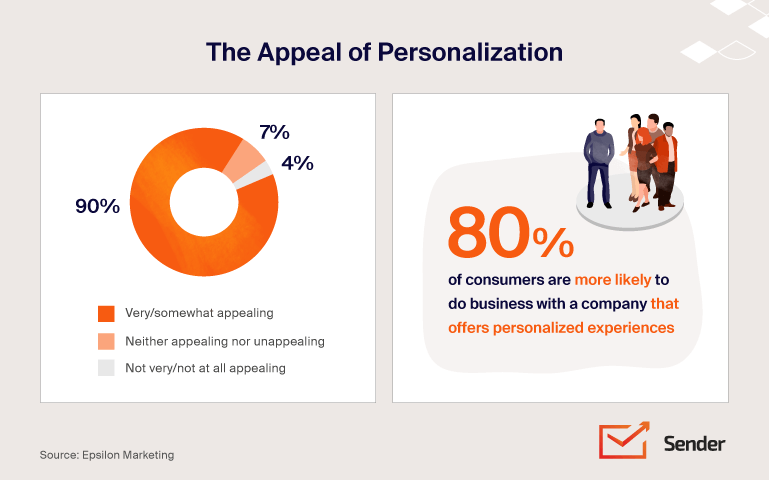
Design Email Campaign
Now, it’s time to design emails that capture attention and inspire action! Here are some tried and tested email design tips to stand out in a crowded inbox:
Pay Attention to Email Subject Line & Preheader
These are the first things your email recipient see, so make it count:
- Subject line. The subject line is your one shot to convince subscribers to open your email. Keep it concise, benefit-oriented, and pique their curiosity. Think of it as the headline of your email – it needs to grab attention;
- Preheader. The preheader is the snippet of text that appears after the subject line in the inbox preview. Use it to expand on your subject line’s promise and entice subscribers to take that next step and open. It’s your chance to provide a sneak peek of the value waiting inside;
- Sender name. Make it abundantly clear who the email is from. Use your brand name or a recognizable name your subscribers associate with positive experiences.
Offer Value-Focused Content
Your email content should always focus on the recipient’s needs, not just your business goals. So, always deliver something that makes your reader’s life easier, or better.
- Start with a clear headline. Make it instantly clear why the email is worth reading;
- Keep your copy concise. Use short paragraphs and break up text with images or bullet points;
- Send useful info. Share tips, exclusive offers, or helpful resources that help your subscribers achieve their goals.
Focus on Email Personalization
Personalized email marketing is the key to cutting through the noise in today’s inbox. Go beyond simply addressing your subscribers by their first name – make them feel like you’re speaking directly to them. You can’t go wrong with these email personalization techniques:
- Segment your list. We’ve said it before, and we’ll say it again – segmentation is paramount. Tailor your messages based on demographics, interests, behaviors, and past purchases to deliver a personalized experience;
- Use dynamic content. Show different content to different segments within the same email based on their preferences. For example, if you have a clothing store, showcase men’s apparel to your male subscribers and women’s apparel to your female subscribers;
- Recommend relevant products. Leverage the power of past purchases and browsing history to recommend products your subscribers are likely to be interested in;
- Celebrate milestones. Acknowledge birthdays, anniversaries, or other special occasions with personalized messages or exclusive offers.
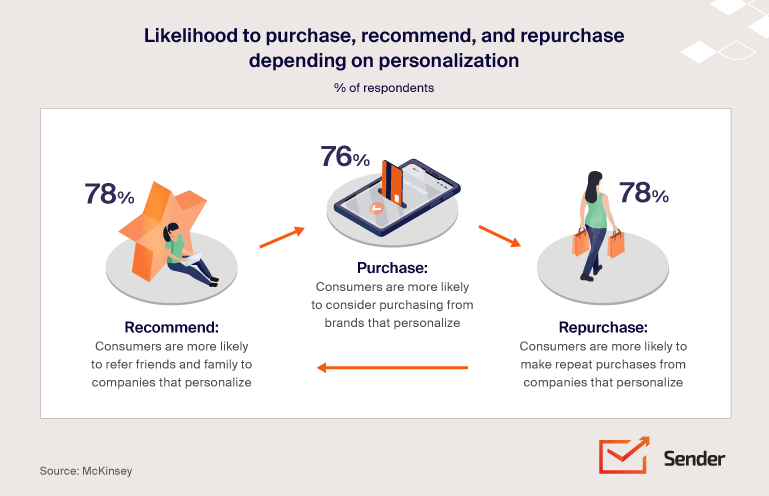
Choose an Email Template
No need to reinvent the wheel! Most email marketing platforms offer a library of professionally designed email templates you can customize to reflect your brand’s visual identity.
In our mobile-first world, it’s crucial to ensure your emails render beautifully even on the smallest mobile devices. Opt for responsive email templates that automatically adjust to different screen sizes, providing a seamless experience for your subscribers, whether they’re on their smartphones, tablets, or desktops.
Create Engaging Email Content
Your email content is where you truly connect with your audience on a deeper level. Here are some email copywriting tips marketers swear by:
- Keep it concise and scannable. People are time-pressed. Use short paragraphs, bullet points, headings, and subheadings to make your emails easy to digest. Think of it as bite-sized chunks of information;
- Focus on benefits, not features. Don’t just tell people what your product or service does – highlight how it will make their lives easier, better, or more fulfilling. Agitate their pain points and present your offering as the solution;
- Use a conversational tone. Write as you would speak to a friend, not a corporation. Inject your brand’s personality into your copy, but always maintain a professional and respectful tone;
- Include eye-catching visuals. Images, GIFs, and videos can make your emails more visually appealing and engaging. A well-placed visual can break up text-heavy sections and keep readers interested.
Include a Clear CTA (Call-to-Action)
What do you want your subscribers to do after reading your email? Make it crystal clear with a strong, compelling call to action.
- Use action-oriented language. Employ verbs that inspire action, such as “Shop Now,” “Learn More,” “Download Your Free Guide,” or “Claim Your Discount;”
- Make your CTA button stand out. Use contrasting colors, bold text, white space, and visual cues to draw attention to your CTA button.
Test and Optimize Overtime
Email marketing is never a one-and-done process. In fact, it’s a cyclic process requiring you to stay focused and keep testing.
Every time you send an email, you gather valuable data, which you should use to analyze performance and tweak your future campaigns to understand your audience and improve your strategy.
Here are the key metrics to track in email marketing analytics:
- Open rates. Your open rate tells you how many people are opening your emails. If you’re seeing low open rates, improve subject lines and preheaders to make them more engaging;
- Click-through rates (CTR). This measures how many recipients click on links in your email. Use clear, compelling CTAs and ensure your email content is relevant;
- Conversion rates. This shows how many people took the desired action, like buying or clicking a link. For conversion rate optimization, focus on personalizing emails and using clear CTAs;
- Unsubscribe rates. A high unsubscribe rate might indicate your emails aren’t meeting expectations. Review email frequency and avoid being overly promotional.
Analyze your previous campaigns for all the above key metrics to identify trends. What worked well? What fell flat? Use those insights to improve your next email.
Apart from that, you should also do the following to improve campaign performance:
- A/B testing emails. Test specific elements like subject lines, CTAs, or email layouts in your campaigns. Compare results and implement the winning variations in future emails;
- Segment your audience. Divide your list into smaller groups based on behavior, demographics, or preferences and send targeted messages;
- Experiment with timing. Try sending emails at different times or days to find when your audience is most responsive;
- Ask for customer feedback. Send occasional surveys to ask your subscribers what they think about your newsletters and what they’d like to see in your future emails.
Automate Your Campaigns
Automation is about to become your new best friend – it saves time, optimizes your workflow, and allows you to nurture leads and engage subscribers even while you’re off-the-clock. Setting up automated email sequences, often referred to as drip campaigns, can work wonders for your email marketing ROI.
Drip campaign
Drip campaigns are pre-written email sequences triggered by specific actions or timelines. They allow you to deliver timely and relevant messages to your subscribers without lifting a finger.
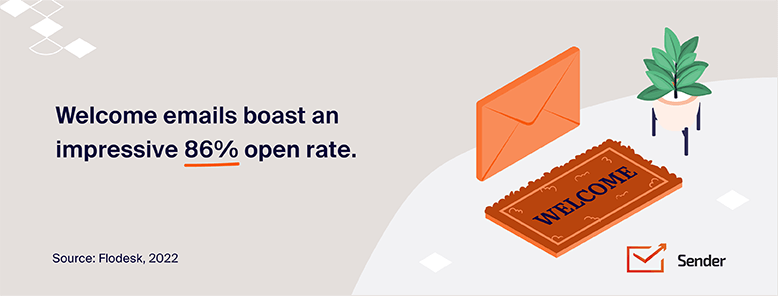
Here are a few examples of powerful drip campaigns:
- Welcome email series. Make a stellar first impression and set the tone for a lasting relationship with a series of automated welcome emails. Introduce your brand, showcase your best content, offer exclusive discounts, and gently guide new subscribers toward becoming loyal customers;
- Lead nurturing emails. Guide your leads through the sales funnel with automated email sequences that provide valuable information, resources, and incentives to help them make informed purchasing decisions.
- Abandoned cart emails. Recover lost sales and boost your revenue by sending automated reminders to subscribers who abandon their shopping carts. Consider including images and descriptions of the abandoned products to entice them to return and complete their purchase;
- Post-purchase follow-up (customer retention emails). Increase customer lifetime value and foster brand loyalty with targeted post-purchase emails. Offer product recommendations, upsells, cross-sells, or loyalty program incentives to keep existing customers engaged and coming back for more;
- Re-engagement campaigns. Don’t let inactive subscribers fade into oblivion. Win them back with a series of re-engagement emails that offer valuable content, exclusive deals, or simply a friendly reminder of what they’re missing.
Email Marketing Examples to Inspire your First Campaign
Short of inspiration about what to include in your first email campaign? We’ve curated some interesting email marketing examples from brands who’re nailing their game. And the best of all – you can easily recreate them with email marketing templates!
Last Crumb — Welcome Email Example
Welcome emails are one of the most important emails you will ever send. It sets the foundation for the future relationship with the subscriber. Here’s an example of a great welcome email by Last Crumb:
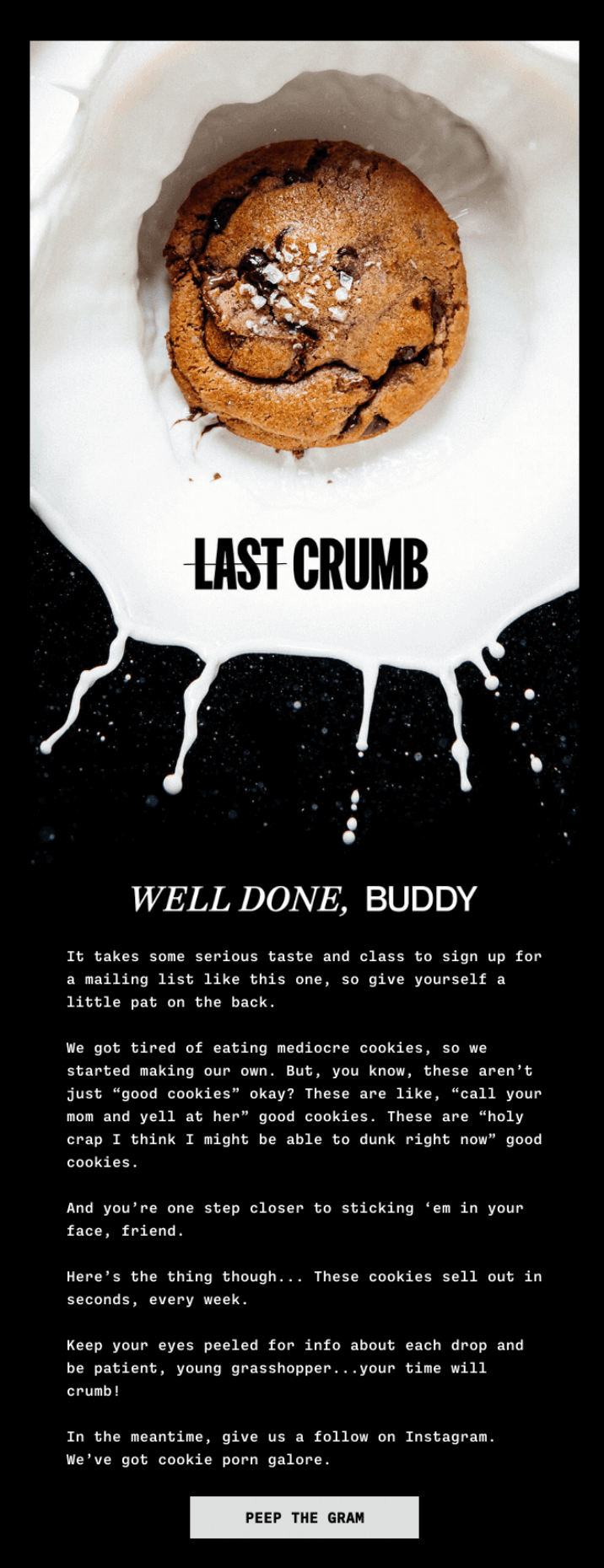
The welcome email is great at creating an instant connection. This personalized letter with an appealing header image makes the reader feel special. The talk about brand values in the welcome email is an excellent idea, as most consumers are attracted to brands with a strong ethos.
Why it works?
- Relatable and warm email copy;
- Simple and minimalist design;
- Reassurance and confidence towards brand values.
Scott’s Cheap Flights — Monthly Newsletter Example
Monthly newsletters are updates a brand sends to its subscriber list informing them about the latest happenings. Generally, newsletters have a common theme and reach out to users on a weekly, bi-weekly, or monthly basis.
Here’s a great example of a monthly newsletter by Scott’s Cheap Flights:
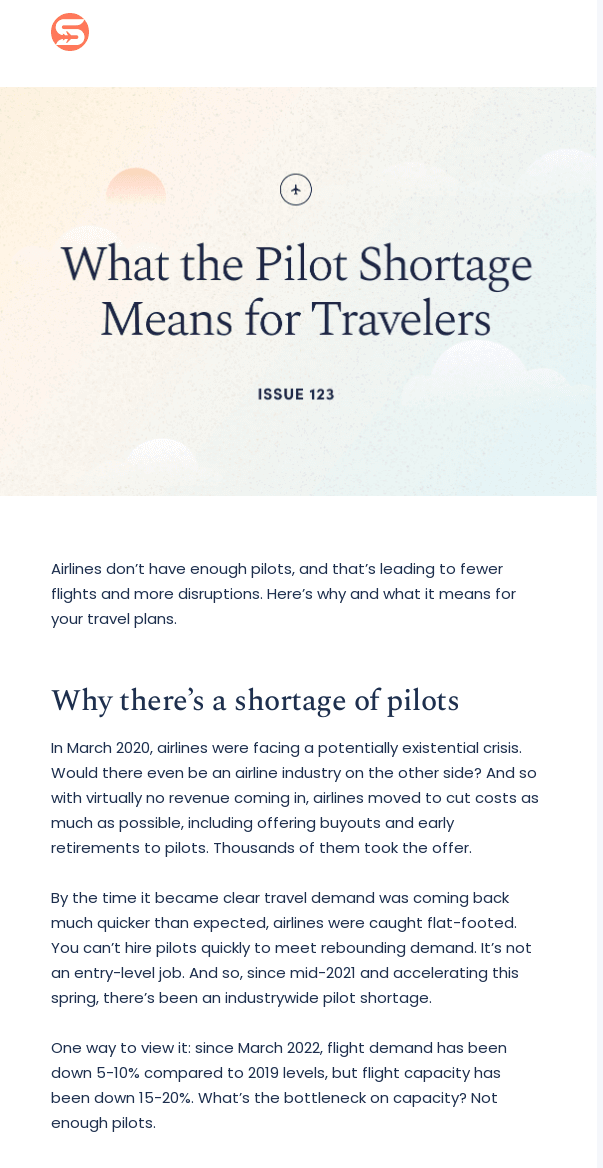
The company sends a monthly newsletter touching on a relevant topic and sharing its take on the issue. The newsletter email discusses the issue and shares relevant messages, articles, blogs, and more for the reader, just like a magazine.
Why it works?
- Reminds users about your brand or business;
- Adds value to subscriber’s life consistently;
- Shares things that they’d love to read on a regular basis;
- Plus, such seasonal email campaigns ensure that the content is always relevant.
Gold Belly — Promotional Email Example
Promotional email campaigns tell subscribers about your latest offers, sales, discounts, or deals on your product range. It’s a great way to remind them about you, generate interest, and increase sales by luring interested customers to buy.
Here’s an example of a successful email marketing campaign by Gold Belly:
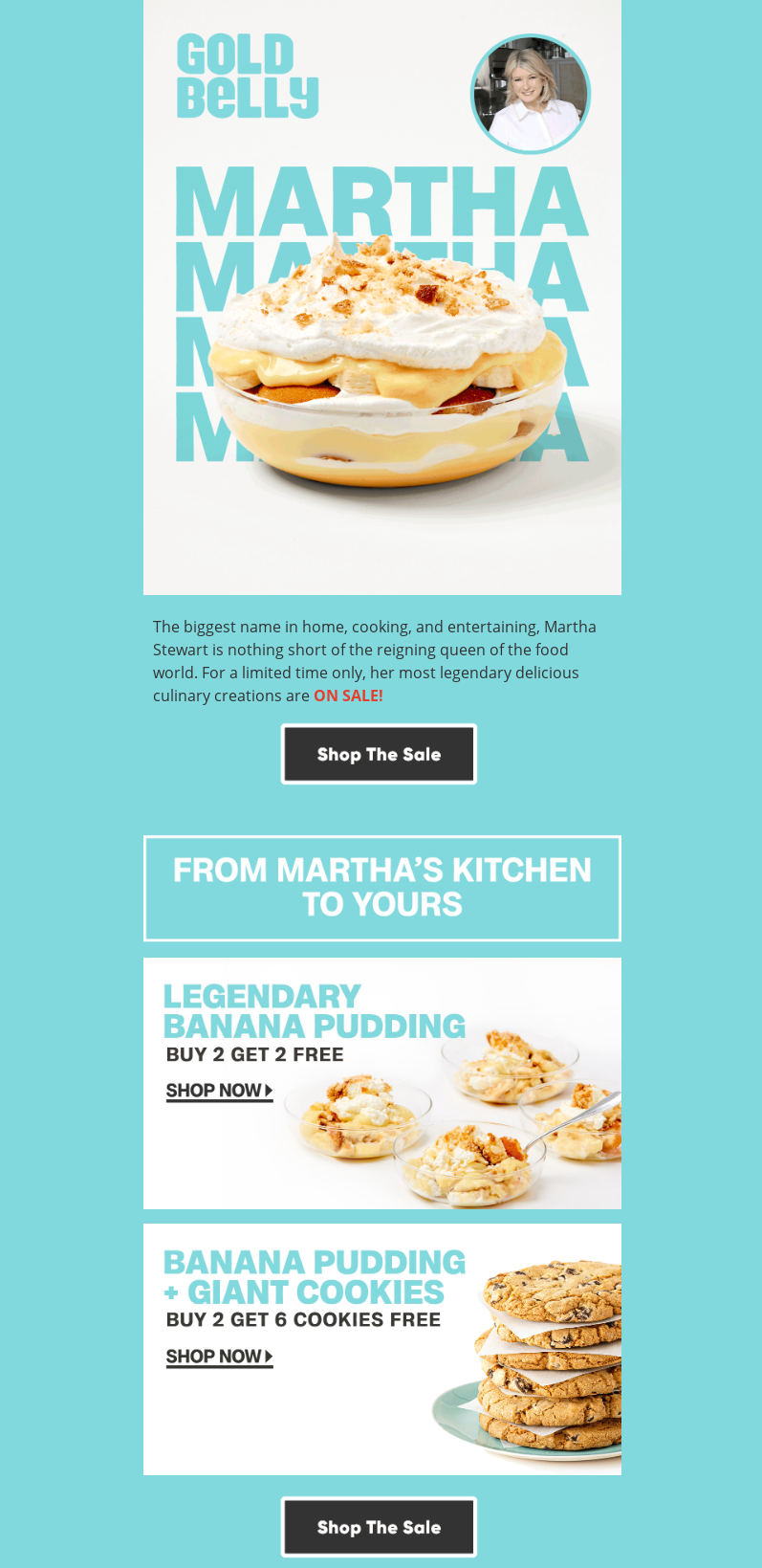
The refreshing email has a striking and eye-catching design. Plus, the reference (and social credential) to Martha Stewart is an ice-breaker, making the subscriber consider buying from the brand.
The promotional email has excellent offers, a subject line that stands out (Banana Pudding on Sale — Martha Steward APPROVED! ), and great CTAs to make an impact.
Why it works?
- Attention-grabbing subject line;
- Beautiful email design;
- Social proof embedded within the email;
- Great contextual offers that tempt users to make a purchase.
Best Practices for Email Marketing
Here are a few email marketing best practices to ensure your efforts are met with open arms (and inboxes):
- Keep your emails mobile-friendly. Design for smaller screens and test how your emails look on different devices. A significant portion of your audience will be opening your emails on their smartphones, so mobile optimization is non-negotiable;
- Avoid spammy language and overloading with links. Focus on providing value and building relationships, not bombarding your subscribers with salesy language or an overwhelming number of links. Keep your emails focused and easy on the eyes;
- Maintain a consistent sending schedule. Don’t leave your subscribers guessing when they’ll hear from you. Establish a regular sending cadence (e.g., weekly, bi-weekly, monthly) and stick to it. Consistency builds trust and anticipation;
- Clean your email list regularly to remove inactive subscribers. Regularly pruning your email list not only improves your deliverability rates but also ensures you’re only sending to engaged subscribers who genuinely want to hear from you.
Create an Email Marketing Calendar
An email marketing calendar helps you stay organized, plan your content in advance, and maintain a consistent sending schedule.
Here’s how to create your email marketing calendar:
- Map out your campaigns. Determine which types of email campaigns you want to send (newsletters, promotional emails, re-engagement campaigns, etc.) and how often you want to send them (weekly, bi-weekly, monthly);
- Plan your content. Brainstorm content ideas for each campaign and schedule dedicated time to write, design, and schedule your emails. Consider the needs and interests of your target audience;
- Consider seasonality and holidays. Capitalize on seasonal trends and holidays with themed email campaigns. For example, create a back-to-school campaign in August or a holiday gift guide in December;
- Use a project management tool. Tools like Asana, Trello, or Google Calendar can help you visualize your email marketing calendar, set deadlines, and collaborate with your team.
Stay Compliant with Email Regulations
Email marketing regulations are in place to protect consumers from spam and ensure ethical email practices. Familiarize yourself with the CAN-SPAM Act guidelines outlined in this legislation to avoid penalties and maintain a positive sender reputation.
Here are some key compliance tips to help you with spam filter avoidance (and some serious fees):
- Provide a clear and easy way to unsubscribe. Every email you send should include a visible and functional unsubscribe link, typically located in the email footer;
- Honor unsubscribe requests straight away. When a subscriber opts out of your emails, honor their request immediately. Don’t try to sneak them back onto your list or make it difficult for them to unsubscribe;
- Identify yourself and your business. Clearly identify yourself and your business in the sender name and email footer. Include your business name, physical address, and contact information.
FAQs about Email Marketing
What is the best email marketing platform for beginners?
Sender is an excellent choice for email marketing newbies. It has a user-friendly interface, affordable pricing plan, and all the essential features you need to get started.
How often should I send marketing emails?
There’s no magic number when it comes to email frequency – it depends on your audience, your industry, and your goals. However, it’s generally recommended to send emails at least once a month to stay top-of-mind. You can experiment with different frequencies and monitor your engagement metrics to find the sweet spot for your audience.
And don’t forget to follow email deliverability tips – a bounced email is as good as no email.
How can I grow my email list quickly?
Focus on creating valuable lead magnets that entice people to subscribe, promoting your email list on your website and social media channels, and using pop-up forms strategically to capture leads. Remember, quality over quantity – it’s better to have a smaller list of engaged subscribers than a large list of uninterested contacts.
What are the best ways to avoid spam filters?
Here are a few tips to reduce spam complaints to a minimum:
- Use a reputable email marketing service. Choose an email service provider with a good sender reputation and robust spam-fighting measures in place;
- Avoid spammy language. Refrain from using excessive exclamation points, ALL CAPS, or words and phrases commonly associated with spam, such as “free,” “guarantee,” or “make money fast;”
- Don’t buy email lists. Building your email list organically is crucial. Buying email lists is a surefire way to trigger spam filters and damage your sender reputation;
- Maintain a healthy text-to-image ratio. Spam filters are more likely to flag emails that are heavy on images and light on text;
- Use a double opt-in. Implement double opt-in to ensure that only valid and engaged subscribers are added to your list;
- Monitor your email deliverability. Regularly check your email deliverability rates and investigate any sudden drops.
If you’re not full of marketing insights yet, here’s more great content: 11 Expert-Backed Email Marketing Tips



